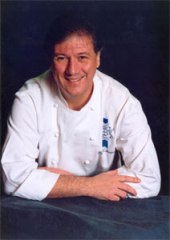AIGUILLETTE DE BOEUF MODE (Braised Beef Rump Roast)
Super User |
 |
By Patrick Martin and Brian Mattingly, CEC, CCE
Le Cordon Bleu Schools North America
This lesson plan was delivered to a standing-room-only audience of culinarians and students at the American Culinary Federation’s 2006 National Convention in Philadelphia in July by Patrick Martin, vice president of culinary-education development for Le Cordon Bleu International based in Paris, and Brian Mattingly, CEC, CCE, executive chef of California Culinary Academy in San Francisco. Martin also serves as international ambassador for Le Cordon Bleu.
The classic recipe from Auguste Escoffier for a braised-beef rump roast was demonstrated without a handout listing procedures or rationales (for example, the use of a veal foot adds needed gelatin) to encourage cognitive learning and promote discussion between the instructors and learners. Tasting by the audience concluded the instruction. This exercise should include evaluation and teacher reflection.
AIGUILLETTE DE BOEUF MODE (Braised Beef Rump Roast) Recipe
Overview
A demonstration of a classical French recipe prepared using traditional methods. Students will be able to observe time-honored culinary skills and sample finished product
Key vocabulary
-
Braiser
-
Blanchir
-
Pocher
-
Fermiere
-
Napper
-
Fond Brun
-
A point
-
Larder
-
Reducir
-
Mijoté
-
Farcir
-
Découper
Goal(s)
Familiarize students with classical culinary techniques associated with the recipe being presented through a combination of demonstration, discussion and tasting.
Objectives
• Observe classical technique of braiser
• Observe classical technique of pocher
• Observe classical technique of blanchir
• Observe classical technique of larder
• Observe classical approach to garniture
Materials and Resources
• Recipe
• Student handouts
• Overhead mirror or closed-circuit camera and monitors
• Equipped demonstration kitchen – specs listed separately
• Demonstration ingredients
• Appropriate audio equipment for instructor
• Texts:
Professional Cooking, 6E, Gisslen (John Wiley and Sons, 2005)
Escoffier Cookbook (Crown Publishing, 1996)
Procedures
A. Introduction
1. History of classical cooking from Le Cordon Bleu perspective
2. Discuss the specific cut of beef and appropriate handling and cooking
3. Review vocabulary associated with this recipe
4. Discuss origin of the recipe from Escoffier #1429
B. Development
1. Prepare recipe using recipe provided.
2. Explain key points in cooking:
a. Searing and color development
b. Different methods of braising – a ragôut, a brun, a blonde, blanquette, etc.
c. Discuss vegetable cuts used in association with this recipe
d. Explain significance of garniture
3. Provide finished presentation of recipe on platter
C. Checking for understanding
1. Seek questions from students and pose questions related to demonstration.
2. Provide recipes without method specified to encourage cognitive learning.
D. Closure
1. Provide tasting-size portions of recipe to students and seek feedback based on flavor and cooking technique.
Patrick Martin
eat Britain Margaret Thatcher and the King of Morocco and, in observance of the French Bicentennial in 1990 at the French Embassy in Washington, D.C., he reproduced the wedding dinner of General Jean de Lafayette. Martin is based in Paris.
Brian Mattingly, CEC, CCE
Mattingly started his culinary career in 1975 at the prestigious Connaught Hotel in London. After a rigorous four-and-a-half-year apprenticeship, he joined the famous Roux brothers at Le Gavroche, also in London. Le Gavroche later became the first three-star Michelin restaurant in England.
From Le Gavroche, Mattingly was recommended by Albert Roux to work with the world-famous three-star chef, Alain Chapel, of Lyon, France. Chapel was creative beyond his time, and when he died in 1991, Mattingly realized how fortunate he was to have worked with this master.
In the mid-1980s Mattingly took his knowledge to San Francisco and started a gourmet delicatessen/catering business on Russian Hill, which he operated for two years. He then went on to consult for restaurants and country clubs in the Bay Area for several years before taking a position at the famed Ernies restaurant in San Francisco.
In 1989, Mattingly decided to give back to the community what the community gave to him and took a teaching position at the California Culinary Academy. After a teaching rotation in almost every class at CCA, he pursued the title of executive chef at Sharon Height Golf and Country Club in the Silicon Valley. Mattingly returned to CCA in January 2001 to become the academy’s executive chef.
Leave a comment
Make sure you enter all the required information, indicated by an asterisk (*). HTML code is not allowed.

